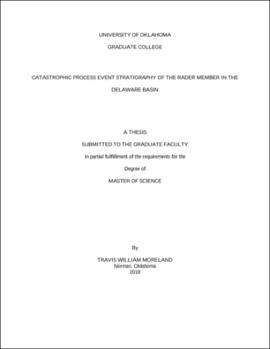| dc.description.abstract | The Bell Canyon Formation, Middle Rader Member, debrite crops out in Guadalupe Mountains (along Highway 62, McKittrick Canyon and vicinity) revealing a Late Guadalupian catastrophic submarine debris slide. The formation contains reefal boundstone clasts, up to ~5m diameter, suspended in a sandy matrix. Above this deposit are two distinct hummocky cross-stratification (HCS) cosets. The overlying 0.3 to 0.5m amplitude and 2m strike wavelength HCS structures exhibit internally poorly graded gravel to silt-sized intraclasts and fossils within a muddy matrix, a vast difference from the lower mega-breccia.
Compared to modern sedimentological investigations which often study the relationships between hydrological parameters and observable bedforms (a forward problem) this investigation utilizes a variety of tools: LiDAR, XRF, thin sections, and grain-size analyses to determine the conditions during deposition from observed bedforms (an inverse problem). Paleo-bathymetric reconstructions and anoxic XRF indicators indicate that the commonly accepted processes of shallow water storm waves as the origin for these HCS beds is unlikely. Therefore, a deep-water, upper-flow-regime anti-dune interpretation for these bedforms appears to be more likely.
To test this hypothesis, a reconstruction of the decompacted isopachs of two Middle Rader debris slides was conducted for the northwest and eastern sides of the basin. Each of these slides contains an approximate minimum of 50 km3 of sediment. High Performance Computing (HPC) was conducted at the University of Delaware using NHWAVE to model the submarine slides and a fully nonlinear Bousinesq FUNWAVE-TVD program for the wave generation. The numerical models revealed these slides would have created a tsunami wave more than 30m in height with open sea speeds of 185mph, with the ability to generated Froude numbers exceeding 0.84 at water depth greater than 300m. Such hydrologic conditions are consistent with the formation of the observed deep-water anti-dune HCS.
Integrating the event stratigraphy of these results suggests that portions of the pre-fractured Capitan reef became partially exposed and unstable during a global and local sea level lowstand, possibly initiated by earthquakes caused by the Gondwanan-Lurassian collision to the south as likely triggers. Through outcrop analysis, a number of tsunamiites (HCS beds) are observed in the Rader Formation, suggesting multiple mass-failure events which generated tsunami waves and deep-water anti-dune HCS beds on the sea-floor bottom. | en_US |
